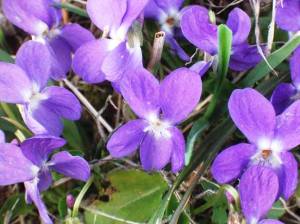Simple violets are among the most romantic and beloved flowers. Ours will soon be in bloom. It seems a fitting time of year for an excerpt from my herbal, Plants for A Medieval Herb Garden in the British Isles.
“Who are the violets now
That strew the lap of the new-come spring?” ~ Shakespeare: Richard II
That strew the lap of the new-come spring?” ~ Shakespeare: Richard II
Violet (Viola Odorata). Part Used: Flowers (dried). The leaves and whole plant (fresh).
Sweet violets grow at the edge of forests and clearings and can be detected by their scent. Sometimes they appear as unwanted guests in yards and gardens, but we like violets and encourage them here. Violets have a long history reaching deep into the misty past. There are over two hundred species in the world; five are native to Great Britain. Sweet violets are usually dark purple, but may be white. The flowers are full of honey and appealing to bees, but usually bloom before bees are really out from as early as late February into April.
 Violets imbue liquids with their color and fragrance and make a divine perfume. A medicinal syrup of violets is given as a laxative considered mild enough for children, and for a variety of other ailments. Old herbalists recommended the syrup for ague (acute fever), inflammation of the eyes, insomnia, pleurisy, jaundice, and many other illnesses. They had great faith in its healing attributes. Among other components, violets contain salicylic acid which is used to make aspirin.
Violets imbue liquids with their color and fragrance and make a divine perfume. A medicinal syrup of violets is given as a laxative considered mild enough for children, and for a variety of other ailments. Old herbalists recommended the syrup for ague (acute fever), inflammation of the eyes, insomnia, pleurisy, jaundice, and many other illnesses. They had great faith in its healing attributes. Among other components, violets contain salicylic acid which is used to make aspirin.
As with primroses, violets have been associated with death, particularly of the young. This is referred to by the poets, including Shakespeare in Hamlet. Ancient Britons used violet flowers as a cosmetic, and in a Celtic poem they are recommended to be employed steeped in goats’ milk to increase female beauty. In the Anglo-Saxon translation of the Herbarium of Apuleius (tenth century), the herb V. purpureum is recommended ‘for new wounds and eke for old’ and for ‘hardness of the maw.’ In Macer’s Herbal (tenth century) the Violet is among the many herbs which were considered powerful against ‘wykked sperytis.’ (A Modern Herbal)
Askham’s Herbal Violet Recipe for Insomnia: “For the that may not slepe for sickness seeth this herb in water and at even let him soke well hys feete in the water to the ancles, wha he goeth to bed, bind of this herbe to his temples.”
To Make Syrup of Violets: Tale 1 lb. of Sweet Violet flowers freshly picked, add 2 ½ pints of boiling water, infuse these for twenty-four hours in a glazed china vessel, then pour off the liquid and strain it gently through muslin; afterwards add double its weight of the finest loaf sugar and make it into a syrup, but without letting it boil. (A Modern Herbal)
“Viola Odorata is an ancient heirloom, which the Greeks used in love potions, and beloved by our grandmothers and their grandmothers because of its sweet perfume, delicate purple to deep bluish purple flower and heart-shaped leaves.” ~ Quote from Cherry Gal, an interesting website that sells heirloom violet seeds, amongst other offerings.
 "I know a bank, where the wild thyme blows Where ox-lips, and the nodding violet grows; Quite over-canopied with luscious woodbine, With sweet musk-roses, and with eglantine." ~ William Shakespeare
"I know a bank, where the wild thyme blows Where ox-lips, and the nodding violet grows; Quite over-canopied with luscious woodbine, With sweet musk-roses, and with eglantine." ~ William Shakespeare
"Look at us, said the violets blooming at her feet, all last winter we slept in the seeming death but at the right time God awakened us, and here we are to comfort you." ~Edward Payson Rod
"You can't be suspicious of a tree, or accuse a bird or a squirrel of subversion or challenge the ideology of a violet." ~Hal Borland, Sundial of the Seasons, 1964
An illustrated collection of plants that could have been grown in a Medieval Herb or Physic Garden in the British Isles. The major focus of this work is England and Scotland, but also touches on Ireland and Wales. Information is given as to the historic medicinal uses of these plants and the rich lore surrounding them. Journey back to the days when herbs figured into every facet of life, offering relief from the ills of this realm and protection from evil in all its guises.





Beth, I prize your PLANTS FOR A MEDIEVAL HERB GARDEN IN THE BRITISH ISLES. Even though I have taken your online course (which is amazing), I enjoy having the book for reference. Best wishes.
ReplyDeleteThanks so much, Caroline. I find it a very useful reference to refresh my own memory.
ReplyDeleteWhat a lovely Springtime post, sweet and informative too. Violets grew in my yard in Illinois, a wonderful childhood memory.
ReplyDeleteThanks. Yes, they are a wonderful memory for many. A reality here. :)
ReplyDeleteYour "herb" posts are always fascinating. I learn something every time I read one.
ReplyDeleteThanks Joan. :) I'm glad.
ReplyDeleteI love violets so of course I thoroughly enjoyed reading your article. Yes, I need this book!
ReplyDeleteThanks so much, Jacquie.
ReplyDelete